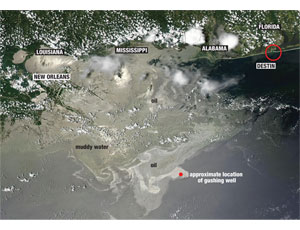As scientists begin to assess the impact of the first tropical storm of the 2010 hurricane season on a massive oil spill in the Gulf of Mexico, the fight to seal the leaking well and protect the coastline continues.
Scientists want to improve their predictions of oil-spill behavior when slicks are assailed by major storms like Tropical Storm Alex, which gained name status on June 26. The storm was nearing hurricane strength on Tuesday afternoon as oil continued to spew from an April 20 blowout of a deepwater well about 60 miles from the mouth of the Mississippi River.
Meteorologists say the center of the storm will stay far away from the accident site. But its broad skirt of counterclockwise winds means heavy seas and several days of strong, easterly winds will likely push the oil west toward Louisiana.
Gregory Stone, director of Louisiana State University’s Coastal Studies Institute, says tropical cyclones add a wild-card factor to oil-spill transport and dispersal projections, with scenarios dependant on the storm’s path, size and magnitude.
BP officials say the bad weather may delay replacement of the containment dome over the leaking well bore to get a tighter seal. BP Senior Vice President Kent Wells reports the new cap may capture the well’s entire flow, but placing it requires three days of smooth seas.
Drilling Delay
Bad weather also may delay the drilling of a relief well designed to intersect the leaking well bore at a depth of 18,000 ft and plug it with drilling mud, capped by drilling cement.
BP said on June 28 that the well has angled from its starting point 3,020 ft away and is now within 20 ft of the leaking bore. Plans call for driving it another 900 ft deeper and edging it to within 5 ft of the wellbore before closure is attempted in early August. BP also is drilling a backup well in case the first well fails.
Onshore, coastal protection efforts continue. The Shaw Group Inc., Baton Rouge, contracted by Louisiana to reinforce barrier islands with berms, got final approval from the U.S. Army Corps of Engineers on June 28 to shift dredging from an environmentally sensitive borrow area to a less sensitive site 17,000 ft from the project area. Despite a five-day dredging hiatus that began on June 23, Shaw placed 12,000 ft of pipe and brought more dredges under contract so it was ready to go when permitted. However, by the time approval was granted, heavy weather had driven most of the vessels off the job and into sheltered waters. “We will go back and resume operations the minute the captain of the vessel approves,” says Shaw’s project manager, Charlie Hess.
Getting Prepared
Oil has hit beaches in Louisiana, Mississippi, Alabama and the Florida Panhandle. Although forecasters predict the oil’s easterly drift will be stalled or even temporarily reversed by Alex, preparation efforts continue. For instance, Okaloosa County, Fla., is mobilizing a pair of plans funded by $500,000 from BP. The goal is to block oil at Destin Pass, an inlet giving access to Destin Harbor, Choctawhatchee Bay, Santa Rosa Sound and the Gulf Intra-coastal Waterway.
According to county spokeswoman Kathy Newby, one project, costing $300,000, uses barges and booms to partially close the pass. The barges are to be ballasted to draw about 3 ft more than usual. Booms with curtains will be attached to funnel oil for collection. Alternately, Newby says the barges also could fully close the pass. “This is a work in progress,” she says. “Our overall plan is to have multiple layers of protection.”
The other project involves placing a perforated air line on the seafloor near the barges to create a curtain of bubbles as an additional barrier, with rising bubbles pushing oil to the surface for skimming. Coastal Planning & Engineering, Boca Raton, Fla., is overseeing the work.



Post a comment to this article
Report Abusive Comment